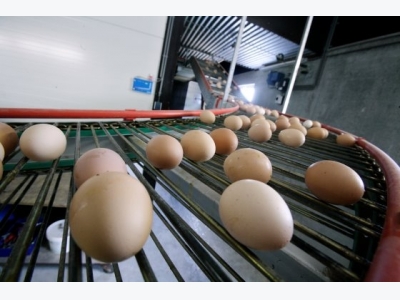Impact of egg sweating on Salmonella penetration

Salmonella enteritidis prevalence in eggs is a major concern to the egg industry.
Salmonella can be introduced into an egg through some 10,000 pores in the shell. Photo: Koos Groenewold
Salmonella can be introduced into an egg through some 10,000 pores in the shell and entry could be facilitated by “egg sweating” or the formation of condensation on shell eggs, when they are moved from a cold to a warm environment with a minimum relative humidity.
Egg sweating occurs at many points during processing and transportation in the egg industry and Salmonella penetration into egg contents can increase when refrigerated eggs are moved to a warmer temperature. This occurs when eggs are tempered before wash, to minimise thermal cracks and before or after cold truck transportation if the ambient temperature and relative humidity permit.
The effect of egg sweating on S. enteritidis penetration into shell eggs over a sixweek storage period at 4°C was assessed. The question to be answered is whether the occurrence of egg sweating is harmful to egg safety. Samples of shell rinse, shell emulsion, and egg contents were enumerated and assessed for prevalence of S. enteritidis over a six week storage period at 4°C. No S. enteritidis counts were obtained from the egg shell rinse, shell emulsion, or egg contents. In these experiments egg sweating did not increase S. enteritidis penetration into the shell emulsion across treatment during the six weeks storage.
The decreasing trend of S. enteritidis prevalence obtained over the study period indicate that refrigeration is effective at inhibiting SE growth. Egg sweating occurring under common egg handling practices is not harmful to egg safety.
Janet A. Gradl, Patricia A. Curtis, Deana R. Jones and Kenneth E. Anderson, Poultry Science
Có thể bạn quan tâm
 Impact of dust, formaldehyde and delayed feeding after hatch
Impact of dust, formaldehyde and delayed feeding after hatch During the hatch window the early birds are exposed up to 36 hours to the hatchers environment. Depending on circumstances dust, formaldehyde and feed
 How acidification of water improves gut health
How acidification of water improves gut health Acidifying water is a key part of eliminating pathogenic bacteria, promoting healthy gut flora and ultimately boosting bird health
 Why use a starter feed from the day the chicks hatch?
Why use a starter feed from the day the chicks hatch? Chicks grow and develop at an incredible rate during the first week of hatching. With just 34-42 days from the beginning to end of the broiler production cycle